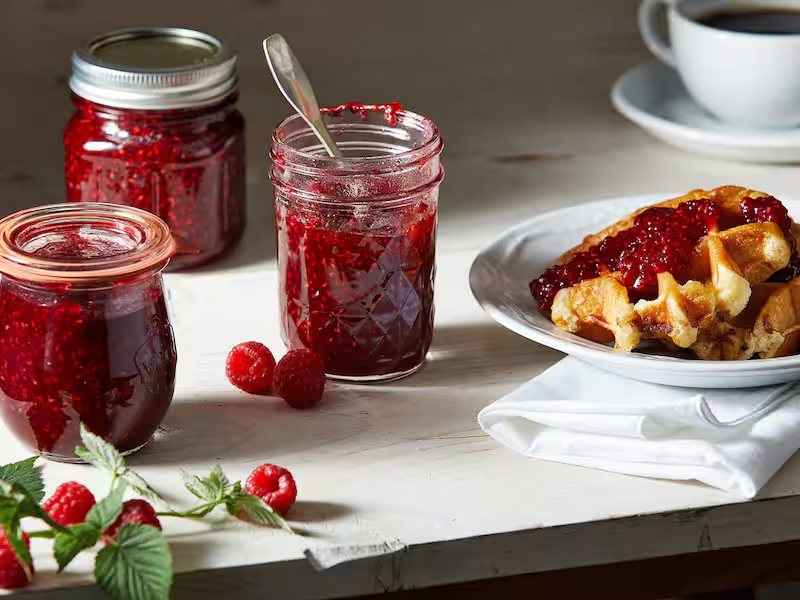
There’s something magical about a spoonful of homemade jam spread across a warm slice of toast. It’s not just the burst of fruit flavor but the love and care woven into every jar. Growing up, my grandmother’s kitchen was a haven of bubbling pots and the sweet aroma of strawberries simmering on the stove. Her secret? No preservatives—just pure, natural ingredients and a sprinkle of patience. Today, I’m sharing that legacy with you, diving deep into the world of homemade jam without preservatives. This guide will walk you through every step, from choosing the freshest fruits to mastering the perfect set, all while keeping things natural, delicious, and safe. Whether you’re a beginner or a seasoned home cook, this blog post will inspire you to create jams that capture the essence of summer in every bite.
Why Go Preservative-Free? The Case for Natural Jam
Preservatives in store-bought jams, like sodium benzoate or potassium sorbate, extend shelf life but can dull the vibrant taste of fresh fruit. Making jam without preservatives lets the fruit shine, offering a cleaner, more authentic flavor. It’s also a healthier choice, as you control the sugar content and avoid artificial additives. According to the Environmental Working Group, some preservatives may pose health risks when consumed in large amounts, making homemade options appealing for health-conscious eaters. Plus, crafting your own jam is a rewarding way to connect with seasonal produce and reduce reliance on processed foods. My first attempt at jam-making was a slightly runny strawberry batch, but the pride of creating something pure and delicious kept me hooked. Let’s explore how to make your own preservative-free jam, step by step.
Choosing the Perfect Fruit: The Foundation of Great Jam
The heart of any jam is the fruit, and choosing high-quality, ripe produce is non-negotiable. Opt for seasonal, locally sourced fruits for the best flavor and texture. According to The Spruce Eats, underripe fruit lacks sweetness, while overripe fruit can lead to a mushy texture. Here’s what to keep in mind:
- Freshness: Pick fruits at their peak ripeness. For example, strawberries should be bright red and fragrant, not soft or moldy.
- Organic Options: Organic fruits, free from pesticides, enhance flavor and align with a natural approach. Check your local farmers’ market for the best picks.
- Variety: Experiment with berries, stone fruits like peaches, or even tropical options like mangoes. Each fruit brings unique flavor profiles and pectin levels.
I learned this the hard way when I tried making apricot jam with slightly unripe fruit—it was tart and lacked depth. Visit your local market, chat with farmers, and let the fruit inspire your jam-making adventure.
Essential Ingredients: Keeping It Simple and Natural
Preservative-free jam relies on just a few ingredients: fruit, sugar, and lemon juice. Each plays a critical role in flavor and texture. Here’s the breakdown:
- Fruit: Provides flavor, color, and natural pectin, which helps the jam set. High-pectin fruits like apples and citrus require less added sugar, per Serious Eats.
- Sugar: Acts as a natural preservative by reducing water activity, inhibiting microbial growth. It also enhances flavor and helps achieve a gel-like consistency. Use granulated white sugar for clarity or cane sugar for a subtle molasses note.
- Lemon Juice: Boosts acidity, which is crucial for safe canning and a balanced taste. It also aids in releasing pectin from the fruit. Freshly squeezed is best, as bottled versions can taste flat.
I once tried cutting sugar to make a “healthier” jam, only to end up with a syrupy mess that spoiled quickly. Balance is key—too little sugar compromises safety and texture, while too much can overpower the fruit. A typical ratio is 1:1 (fruit to sugar by weight), but low-pectin fruits like strawberries may need a 3:4 ratio.
Tools of the Trade: What You’ll Need
You don’t need a fancy kitchen to make jam, but a few tools make the process smoother. Here’s my go-to list, inspired by Ball Mason Jars:
- Heavy-bottomed pot: Distributes heat evenly to prevent scorching.
- Wooden spoon: Ideal for stirring without scratching your pot.
- Mason jars with lids: Sterilized jars ensure safe storage. Aim for 8-ounce or pint-sized jars.
- Tongs and jar lifter: Essential for safe canning.
- Thermometer (optional): A candy thermometer helps check the gel point (220°F/104°C at sea level).
- Funnel: Makes filling jars mess-free.
My first jam-making session was chaotic without a funnel—sticky jam everywhere! Investing in these tools saves time and ensures your jam is safe and delicious.
Step-by-Step Guide to Making Preservative-Free Jam
Ready to dive in? This recipe is for classic strawberry jam, but you can swap in any fruit. It yields about four 8-ounce jars and takes roughly an hour.
Ingredients
- 2 pounds fresh strawberries, hulled and chopped
- 2 cups granulated sugar
- ¼ cup freshly squeezed lemon juice
Instructions
- Prepare the Fruit: Rinse strawberries under cold water and pat dry. Hull and chop them into small pieces for even cooking. Place in a heavy-bottomed pot.
- Macerate (Optional): Mix fruit with sugar and let sit for 30 minutes. This draws out juices, reducing cooking time and enhancing flavor, as noted by Food Network.
- Cook the Jam: Heat the mixture over medium heat, stirring until sugar dissolves. Add lemon juice and bring to a rolling boil. Stir frequently to prevent sticking.
- Test for Set: After 15–20 minutes, check the gel point. Spoon a small amount onto a chilled plate; if it wrinkles when pushed, it’s ready. Alternatively, use a thermometer to confirm 220°F.
- Sterilize Jars: While the jam cooks, sterilize jars and lids by boiling them for 10 minutes. Keep warm until ready to fill.
- Fill and Seal: Ladle hot jam into jars, leaving ¼-inch headspace. Wipe rims, place lids, and screw on bands until fingertip-tight.
- Process (Optional): For longer shelf life, process jars in a boiling water bath for 10 minutes, per USDA guidelines. Cool upright for 24 hours to set the seal.
- Store: Store sealed jars in a cool, dark place for up to 6 months. Refrigerate after opening.
My grandmother taught me to listen for the “pop” of sealing lids—a satisfying sound that signals success. If a jar doesn’t seal, refrigerate and use within a month.
Comparing Fruits for Jam: Which One’s Best?
Choosing the right fruit can make or break your jam. Here’s a comparison of popular fruits, highlighting their pectin content, sugar needs, and flavor profiles.
| Fruit | Pectin Level | Sugar Ratio (Fruit:Sugar) | Flavor Notes | Best For |
|---|---|---|---|---|
| Strawberry | Low | 3:4 | Sweet, slightly tart | Classic jams, spreads |
| Blueberry | Medium | 1:1 | Rich, slightly earthy | Jams, dessert toppings |
| Peach | Low | 3:4 | Juicy, floral | Chutneys, jams |
| Apple | High | 1:1 | Tart, crisp | Jellies, mixed fruit jams |
| Raspberry | Medium | 1:1 | Bright, tangy | Jams, sauces |
This table, inspired by Bon Appétit, helps you pick the perfect fruit for your taste and skill level. I love mixing low-pectin strawberries with high-pectin apples for a naturally thicker jam without extra sugar.
Troubleshooting Common Jam-Making Issues
Even seasoned jam-makers hit snags. Here are common problems and solutions:
- Runny Jam: Likely undercooked or low in pectin. Reheat with a splash of lemon juice or add a grated green apple for natural pectin, per Epicurious.
- Too Thick: Overcooking or too much sugar. Thin with a bit of water or fruit juice during reheating.
- Mold Growth: Improper sealing or insufficient acidity. Always sterilize jars and process them correctly. If mold appears, discard the jam.
- Crystallized Sugar: Undissolved sugar during cooking. Ensure sugar fully dissolves before boiling.
My first blueberry jam was a gloopy disaster because I rushed the cooking process. Patience and a thermometer are your best friends.
Storing and Enjoying Your Jam
Preservative-free jam has a shorter shelf life than commercial versions, but proper storage maximizes its freshness. Unprocessed jars last about a month in the fridge, while water-bath-processed jars can last 6–12 months in a cool, dark pantry, according to the National Center for Home Food Preservation. Once opened, refrigerate and use within 3–4 weeks. Serve your jam on toast, swirl it into yogurt, or use it as a glaze for roasted meats. I once gifted a jar of peach jam to a friend, who used it to elevate a charcuterie board—it was a hit!
Creative Twists: Elevating Your Jam Game
Once you master the basics, experiment with unique flavors:
- Herbs and Spices: Add rosemary to strawberry jam or cinnamon to apple jam for depth.
- Citrus Zest: A teaspoon of orange zest brightens berry jams.
- Low-Sugar Options: Use honey or maple syrup, but adjust ratios carefully to maintain safety, as advised by Cooks Illustrated.
- Mixed Fruits: Combine peaches and raspberries for a vibrant blend.
My rosemary-strawberry jam was a surprise hit at a family brunch, proving that a little creativity goes a long way.
FAQ: Your Jam-Making Questions Answered
Q: Can I make jam without sugar?
A: Yes, but sugar is crucial for preservation and texture. For low-sugar jams, use high-pectin fruits and store in the fridge for short-term use. Commercial low-sugar pectin isn’t preservative-free, so proceed cautiously.
Q: How do I know if my jam is safe to eat?
A: Check for a tight seal (lids shouldn’t pop when pressed). Discard if you see mold, smell off odors, or notice fermentation bubbles. Follow USDA canning guidelines for safety.
Q: Can I use frozen fruit?
A: Absolutely! Frozen fruit retains flavor and pectin. Thaw slightly before cooking, but don’t drain the juices—they add richness.
Q: Why did my jam turn brown?
A: Oxidation or overcooking can cause discoloration. Use lemon juice to preserve color and cook at a steady boil, not a simmer.
Q: How can I make small batches?
A: Scale down the recipe (e.g., 1 pound fruit, 1 cup sugar, 1 tbsp lemon juice) and refrigerate instead of canning for quick use.
Conclusion: Savor the Fruits of Your Labor
Making homemade jam without preservatives is more than a recipe—it’s a journey back to simpler times, a celebration of nature’s bounty, and a chance to create something truly your own. From the first slice of a ripe peach to the satisfying “pop” of a sealed jar, every step is a small victory. My grandmother’s kitchen taught me that food made with love tastes better, and I hope this guide inspires you to fill your pantry with jars of vibrant, preservative-free jam. Start small, experiment with flavors, and share your creations with friends and family. If you’re new to jam-making, try a small batch of strawberry or blueberry jam this weekend. For seasoned cooks, challenge yourself with a unique flavor combo or gift a jar to someone special. Visit your local farmers’ market, grab the freshest fruits, and let the magic of jam-making begin. What’s your favorite fruit to jam with? Share your stories in the comments—I’d love to hear them!
